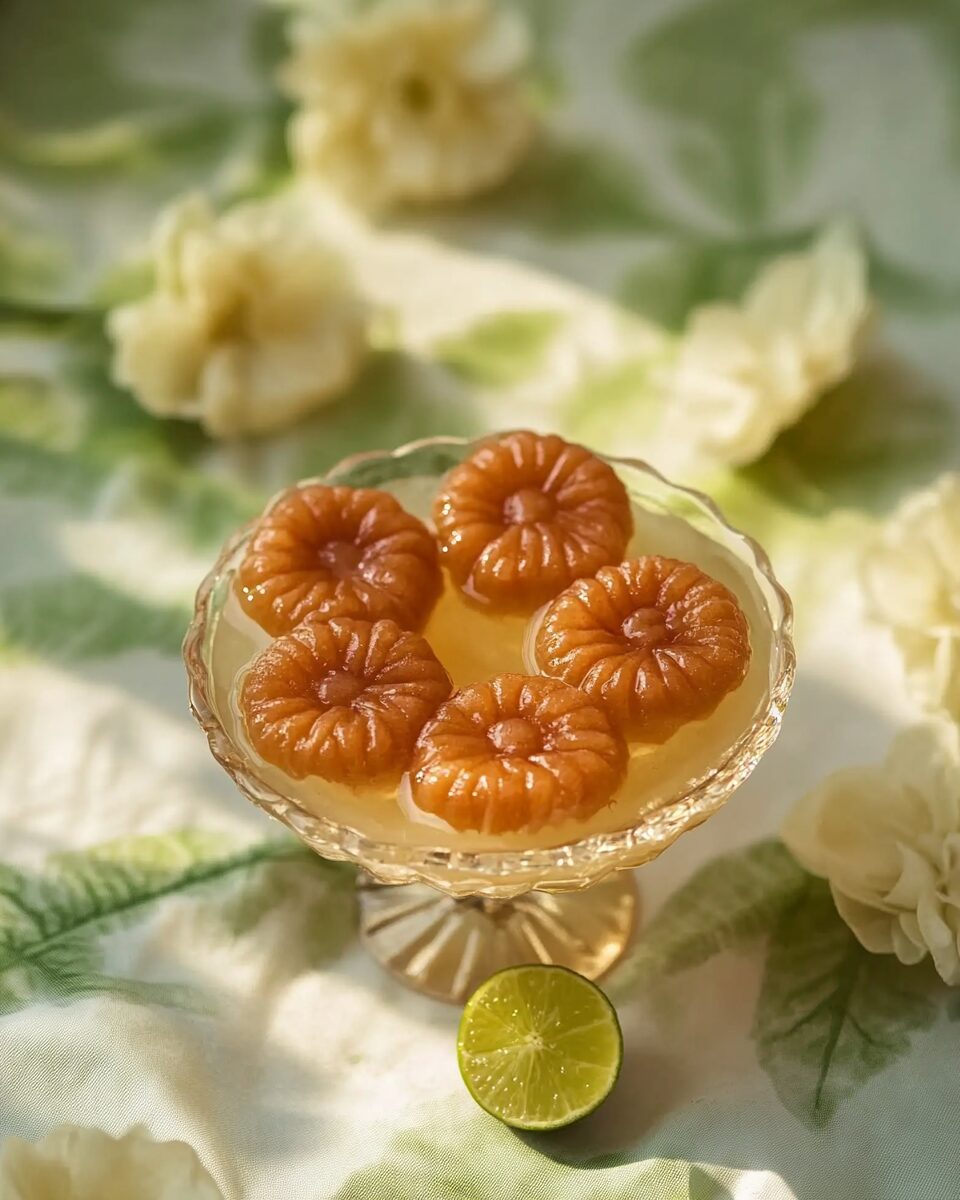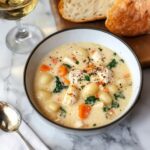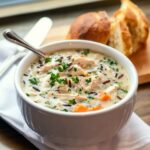Chapssal Yakgwa is a beloved Korean confection known for its chewy texture, golden hue, and deep honey flavor. Traditionally enjoyed during festive holidays, ceremonies, or as a special treat, this pastry holds a significant cultural value in Korean heritage. Made from glutinous rice flour and deep-fried until golden, it is then soaked in a fragrant ginger honey syrup that enhances its sweetness and aroma. Its beautiful flower-like shape also makes it a visual delight, perfect for gift-giving or celebratory spreads.
Full Recipe:
Ingredients
For the Dough:
- 1.5 cups all-purpose flour
- 3 tablespoons sweet rice flour (mochi flour)
- 1/2 teaspoon salt
- 3 tablespoons plus 1 teaspoon sesame oil
- 1/4 cup water
- 1/4 cup sugar
- 2 tablespoons rice syrup
For Frying:
-
Vegetable oil for deep frying
For the Ginger Honey Syrup:
- 1/2 cup rice syrup
- 1/2 cup honey
- 1 cup water
- 1/2 tablespoon grated fresh ginger
Optional Toppings:
- 1–2 tablespoons chopped pine nuts
- Korean sea salt crystals (cheonilyeom)
Directions
-
Prepare the Ginger Honey Syrup: In a saucepan, combine rice syrup, honey, and water. Heat over medium heat and stir to blend. Bring to a gentle boil, then simmer for 2–3 minutes. Remove from heat and stir in grated ginger. Let it cool and infuse.
-
Make the Dough Syrup: In a separate bowl, combine water, sugar, and rice syrup. Heat gently until the sugar dissolves. Set aside to cool.
-
Make the Dough: In a large bowl, combine all-purpose flour, sweet rice flour, and salt. Add sesame oil and rub it into the flour using your fingers until crumbly. Gradually pour in the cooled syrup mixture and mix to form a dough.
-
Shape the Pastries: Roll out the dough to about 1/4 inch thick. Use a flower-shaped cookie cutter or mold to cut out the dough. If you don’t have a mold, simple round shapes work too.
-
Fry the Pastries: Heat oil in a deep pan to around 265°F (130°C). Add the dough pieces, and allow them to rise slowly. Once they float, increase the heat to medium-high and fry until golden brown. Remove and drain on paper towels.
-
Soak in Syrup: While still warm, place the fried pastries into the prepared ginger honey syrup. Let them soak for several minutes until fully glazed and flavorful.
-
Garnish and Serve: Remove from syrup and arrange on a serving dish. Sprinkle with chopped pine nuts or a touch of sea salt if desired.
Nutrients
Per Serving (1 piece, approximate):
- Calories: 120 kcal
- Protein: 1 g
- Carbohydrates: 18 g
- Dietary Fiber: 0.5 g
- Sugars: 8 g
- Fat: 5 g
- Saturated Fat: 0.7 g
- Cholesterol: 0 mg
- Sodium: 50 mg
- Potassium: 20 mg
- Vitamin A: 0% DV
- Vitamin C: 0% DV
- Calcium: 1% DV
- Iron: 4% DV
Cultural Significance and Historical Roots
Yakgwa has deep roots in Korean culinary history, dating back to the Goryeo Dynasty (918–1392). Initially reserved for the royal family and the upper class, it was traditionally consumed during ancestral rites, weddings, and important celebrations. The dessert’s symbolic value is deeply tied to Korean Confucian traditions, where food offerings represent respect, purity, and balance.
Over centuries, Yakgwa made its way from the royal court to the homes of everyday people. It became a staple for Chuseok (Korean harvest festival), Lunar New Year, and other special occasions. The evolution of Yakgwa into Chapssal Yakgwa is relatively recent, a nod to modern palates that favor chewiness—a texture highly prized in many East Asian cultures.
By incorporating glutinous rice flour into the traditional dough, the result is more elastic and mochi-like in texture, while still retaining the honey-sweetness and aromatic notes of its ancestor. Today, this variation is as popular as the classic and continues to be a beloved treat among generations.
Symbolism and Presentation
Chapssal Yakgwa is more than a pastry—it is a visual and symbolic work of art. Traditionally molded into flower shapes, it signifies beauty, celebration, and good fortune. The symmetry and delicate patterning reflect the Korean appreciation for aesthetics, balance, and nature’s geometry.
Its golden color, derived from the frying process and the honey glaze, represents prosperity and abundance. The honey syrup—often infused with ginger—adds another symbolic layer, as ginger is associated with vitality and warmth in Korean traditional medicine.
Often served during tea ceremonies or on special platters during ancestral rites, Chapssal Yakgwa is not just eaten—it’s presented with reverence. Its inclusion in events where formality, respect, and mindfulness are essential underscores the deep emotional and cultural value it carries.
Texture and Taste Profile
What makes Chapssal Yakgwa stand out in the realm of traditional sweets is its unique interplay of textures and flavors. Unlike Western pastries that rely on airiness or flakiness, this Korean dessert is dense, chewy, and moist. The outer surface is lightly crisp from frying, while the interior remains soft and pliable due to the glutinous rice flour.
Flavor-wise, the pastry leans heavily on the natural sweetness of honey, accented by the nuttiness of sesame oil and the warmth of ginger. There’s a floral undertone from the honey that pairs wonderfully with the spicy notes of ginger, while the subtle salt and savory tones from the flour and oil keep it balanced.
These components make Chapssal Yakgwa deeply satisfying without being overly rich. It doesn’t overwhelm the palate, which is part of the reason why it’s often paired with tea. The gentle sweetness and complexity make each bite an experience of layered tradition and flavor.
Modern Adaptations and Popularity
In recent years, Chapssal Yakgwa has experienced a revival, thanks in part to a renewed interest in traditional Korean foods and the global popularity of Korean cuisine. While once seen as an old-fashioned treat, today’s version of Yakgwa is being reimagined by bakers and chefs across Korea and internationally.
Artisanal shops now offer mini Yakgwa, matcha-infused versions, and even chocolate-dipped variations, making it appealing to younger generations. The chewy version made with glutinous rice flour has gained a cult following for its modern mouthfeel and Instagram-worthy appearance.
Tips for Serving and Enjoyment
Chapssal Yakgwa is best served slightly warm or at room temperature. When freshly made, it glistens from its syrup coating and emits a subtle ginger-honey aroma that enhances the tasting experience. Here are a few tips for enjoying it to the fullest:
-
With Tea: Korean traditional teas such as sujeonggwa (cinnamon punch) or omija (five-flavor berry tea) pair exquisitely with the pastry, complementing its sweetness with tart or spiced notes.
-
As a Gift: Wrapped in ornate boxes or placed in decorative tins, Yakgwa is often gifted during holidays or celebrations, symbolizing thoughtfulness and good wishes.
-
Mini Versions: Making smaller, bite-sized Yakgwa is a great way to serve them at parties or large gatherings, making it easier to share and enjoy.
-
Light Reheating: A few seconds in the microwave can revive the chewiness if they’ve been stored in the fridge.
Because of its shelf stability, Chapssal Yakgwa also travels well, making it a thoughtful homemade treat to send to loved ones.
Health Perspective and Nutritional Value
While desserts are generally indulgent, Chapssal Yakgwa holds its own as a more natural alternative to heavily processed sweets. Made with honey, sesame oil, and ginger, the ingredients offer more than just flavor—they provide potential health benefits rooted in traditional medicine.
Honey is known for its antibacterial properties and its ability to soothe digestion. Ginger, on the other hand, is revered for its warming qualities and role in reducing inflammation. Sesame oil contains healthy fats and antioxidants.
Chapssal Yakgwa in Korean Celebrations
The presence of Chapssal Yakgwa at Korean celebrations is not coincidental—it is intentional and symbolic. Whether for weddings, ancestral rites, or milestone birthdays (like hwangap, the 60th birthday celebration), Yakgwa represents continuity, health, and communal sharing.
In ancestral rites (jesa), the pastry is placed on ritual tables as an offering to ancestors. Its purity and beauty are seen as respectful gestures, and its presence signals a connection to heritage and familial bonds.
Craftsmanship and Homemade Value
Making Chapssal Yakgwa by hand is a labor of love. From mixing the dough and shaping each flower to carefully managing the fry temperature and preparing the ginger-infused syrup, the process requires patience and intention. For many Korean families, preparing Yakgwa is a seasonal tradition. Children grow up watching their elders knead the dough and press the shapes into molds, building memories that extend far beyond the plate. This transfer of knowledge and skill is one of the reasons traditional Korean desserts have remained alive in modern times.
Conclusion
Chapssal Yakgwa stands at the intersection of art, flavor, and heritage. As a chewy, golden, honey-soaked pastry, it satisfies the senses while carrying centuries of tradition within each bite. From its role in ancient Korean rituals to its recent resurgence in modern culinary circles, Yakgwa has proven to be both timeless and adaptable.






